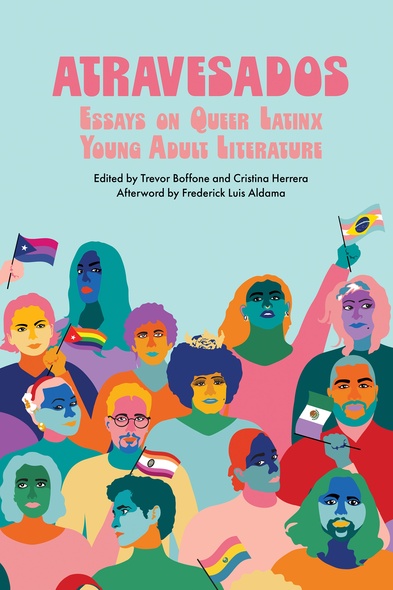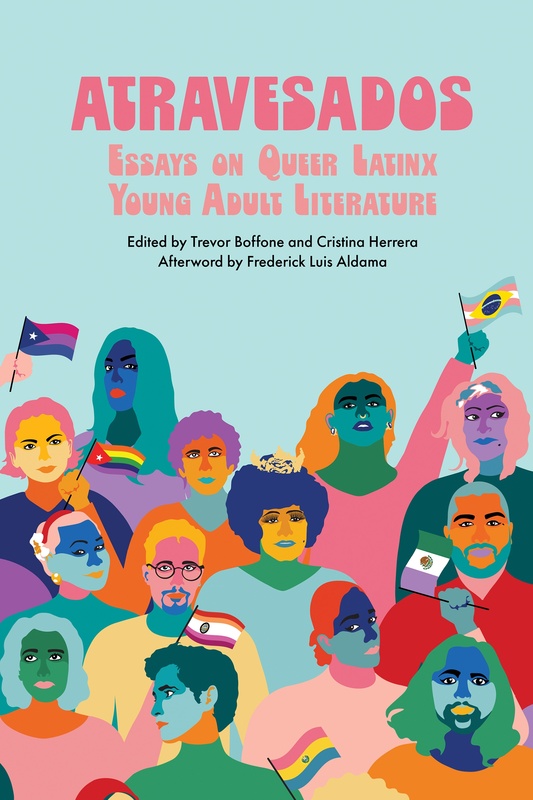
Atravesados
Essays on Queer Latinx Young Adult Literature
Contributions by Frederick Luis Aldama, T. Jackie Cuevas, Alexander Lalama, Angel Daniel Matos, Regina Marie Mills, Joseph Isaac Miranda, Jesus Montaño, Domino Renee Perez, Regan Postma-Montaño, Cristina Rhodes, and Sonia Alejandra Rodriguez
Atravesados: Essays on Queer Latinx Young Adult Literature shows how Latinx queer YA writers discard the “same old story,” and offer critical representations of queerness that broaden YA writing and insist on the presence of queer teens of color. Atravesados draws on foundational Chicana queer theorist Gloria Anzaldúa’s notion of “atravesados” to speak to the spectrum of queer youth Latinidades as they materialize in YA literature. Los atravesados, according to Anzaldúa, are “The squint-eyed, the perverse, the queer, the troublesome, the mongrel, the mulato, the half-breed, the half dead; in short, those who cross over, pass over, or through the confines of the ‘normal.’” Los atravesados reside in the borderlands space of ni de aquí ni de allá, neither here nor there, present yet liminal, their queerness the very source of both frustration and empowerment, a paradox of joy and tragedy. Although written in 1987, Anzaldúa’s theory speaks to the realities of queer Latinx teens that fill the pages of YA literature well into the twenty-first century. Characters such as Juliet from Gabby Rivera’s Juliet Takes a Breath, Aaron from Adam Silvera’s More Happy Than Not, or the titular Chulito from Charles Rice-Gonzales’s novel encompass the highs, lows, and everything in-betweenness of queer Latinx teen lived experiences. This collection tells their stories.
Contributors speak to the spectrum of queer youth Latinidades as they materialize in YA literature, paying close attention to representation and the ways youth are portrayed—whether accurate or stereotypical. Close attention is paid to books that succeed in broadening the field of YA, highlighting authors that draw from their own lived experiences and situate strong, fully developed characters. Taken together, these essays move beyond the page, explaining to readers why representation and authenticity matter in YA literature, as well as the far-reaching effects they can have for real world queer Latinx teens.
A necessary publication that invites us to question and review our notions of Latinidad and gender and sexuality in Latinx YA literature.
Trevor Boffone’s work using TikTok with his students has been featured on Good Morning America, Inside Edition, Access Hollywood, and numerous national media outlets. He is author of Renegades: Digital Dance Cultures from TikTok to Dubsmash and TikTok Broadway: Musical Theatre Fandom in the Digital Age. Boffone is coauthor of Latinx Teens: US Popular Culture on the Page, Stage, and Screen. Cristina Herrera is professor and director of the Chicanx/Latinx Studies Program at Portland State University. She is author of ChicaNerds in Chicana Young Adult Literature: Brown and Nerdy and Welcome to Oxnard: Race, Place, and Chicana Adolescence in Michele Serros’s Writings. Boffone and Herrera are also coeditors of Nerds, Goths, Geeks, and Freaks: Outsiders in Chicanx and Latinx Young Adult Literature, published by University Press of Mississippi.
Acknowledgments
Introduction: Ni de aquí ni de allá: Queering Latinidad, Latinicizing Young Adult Literature
Trevor Boffone and Cristina Herrera
Section One: Articulating the Spectrum of Queer Latinidad
Chapter One. “He Could Still Hear Muffled Voices”: Materializing Queer Latinidad in Aiden Thomas’s Cemetery Boys
Alexander Lalama
Chapter Two. When Bisexuality Is Spoken: Normalizing Bi Latino Boys in Adam Silvera’s They Both Die at the End
Trevor Boffone
Chapter Three. Latinx Queer Worldmaking: Boys Loving Boys in Latinx Children’s and Young Adult Literature and Film Adaptations
T. Jackie Cuevas
Chapter Four. “Everyone Is Gay”: Queer Latina Identity in Isabel Millán’s Chabelita’s Heart and Gabby Rivera’s Juliet Takes a Breath
Sonia Alejandra Rodríguez
Section Two: Queerness and Bodies in Transformation
Chapter Five. Transformation and the Queer Latinx Body in the Collected Works of Anna-Marie McLemore
Cristina Rhodes
Chapter Six. “We Are Something New”: Disability and Latinx Adolescence in Mia García’s The Resolutions
Cristina Herrera
Chapter Seven. “Breathing Room”: Sustaining Queer Brown Socialities in the Latinx Bildungsroman
Joseph Isaac Miranda
Section Three: (Alternative) Spaces of Queer Latinidades
Chapter Eight. Queering TikTok: Gen Z’s Latinx BookTok and Adam Silvera’s They Both Die at the End
Trevor Boffone
Chapter Nine. Sideways Latinx Queerness in Young Adult Video Games: Life Is Strange 2 and Gone Home
Regina Marie Mills
Chapter Ten. Atravesando Nepantla: Queer Familia in Chicanx and Mexican Young Adult Novels
Jesus Montaño and Regan Postma-Montaño
Section Four: Queer Futurities
Chapter Eleven. Roses and Remedios: La Llorona’s Queer Children in When the Moon Was Ours
Domino Renee Perez
Chapter Twelve. “Silence, at Least Right Now, Equals My Survival”: The Absence of AIDS in the Aristotle and Dante Series
Angel Daniel Matos
Chapter Thirteen. Imagining the Future: The (Im)Possibilities of Queerness in Two Latinx Speculative Young Adult Novels
Cristina Rhodes
Afterword: Daydreams Made Real: New Narrative Maps of Resplendent Queer Latinx Futurities
Frederick Luis Aldama
About the Contributors
Index





